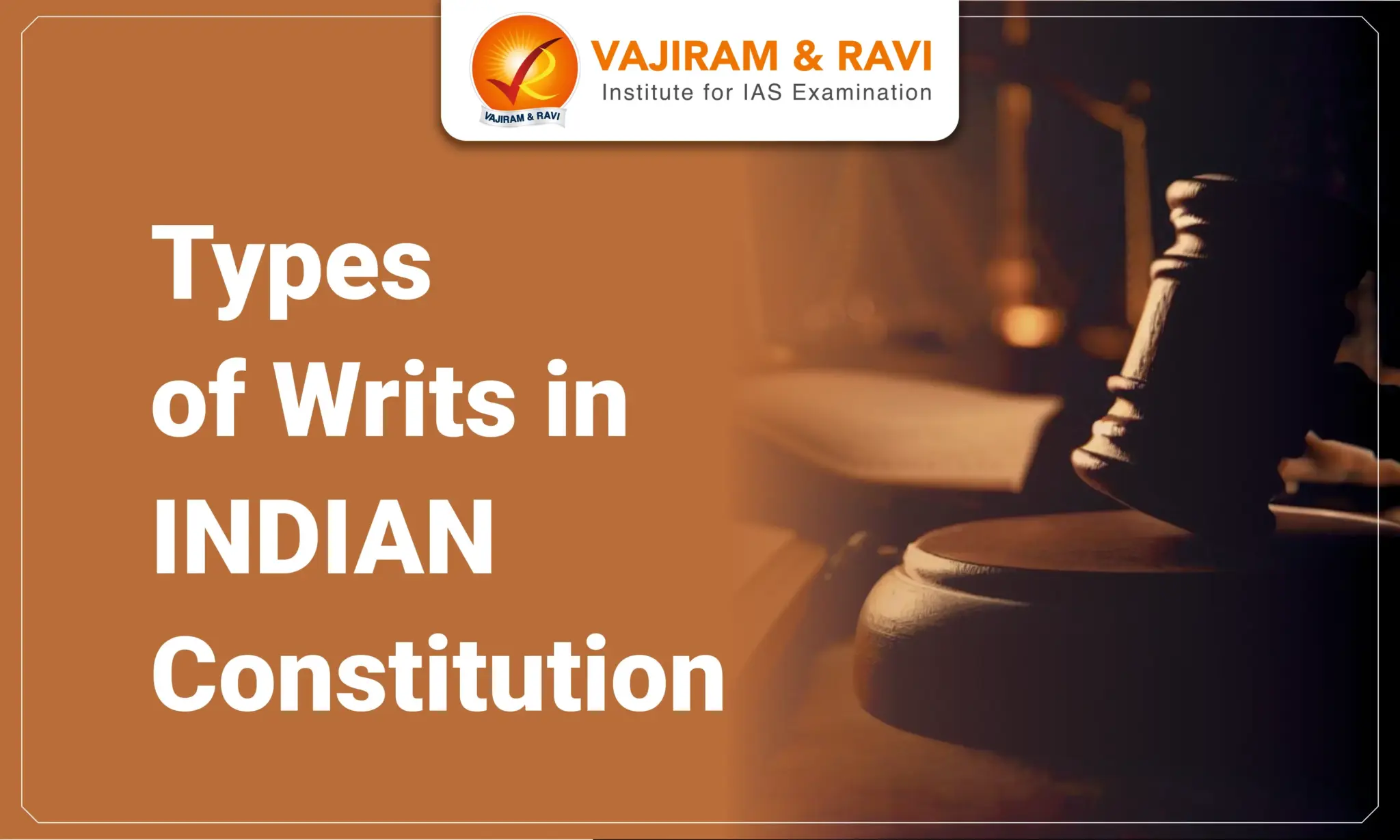A writ is a formal written order issued by a judicial or administrative authority, serving as a crucial legal remedy for safeguarding fundamental rights and ensuring accountability of public authorities. In India, writs form a cornerstone of the legal system, empowering individuals to seek judicial intervention when their rights are violated or when government authorities fail to act by the law.
Writs are borrowed from English law, where they are known as ‘prerogative writs’. They were originally issued under the prerogative of the King. This legal tradition has been adapted into the Indian Constitution, making writs a fundamental part of judicial review.
Writs Constitutional Provisions
The power to issue writs is granted to the Supreme Court and High Courts under Articles 32and 226 of the Constitution of India, respectively. These articles play a key role in ensuring judicial review and safeguarding the fundamental rights of citizens.
- Article 32: This article gives the Supreme Court the authority to issue writs to enforce fundamental rights. It is often called the “heart and soul” of the Constitution because it allows individuals to directly approach the apex court for relief.
- Article 226: This article empowers High Courts to issue writs for the enforcement of fundamental rights and any other purpose, giving them broader jurisdiction compared to the Supreme Court.
Types of Writs
The Indian legal system recognizes five primary types of writs, each serving distinct purposes in protecting individual rights and ensuring the proper functioning of public authorities. These writs are mechanisms through which courts can intervene in cases of unlawful actions or omissions by the government and its agencies.
Habeas Corpus
Habeas Corpus is a Latin term that means “to have the body of.” This writ is an order issued by a court to a person who has detained another individual, compelling them to produce the detained person before the court. The court then examines the reasons and legality behind the detention. If the detention is found to be unlawful, the court will order the immediate release of the detained person. The writ of Habeas Corpus can be issued against both public authorities and private individuals.
However, the writ of Habeas Corpus will not be issued in cases where:
- the detention is lawful,
- the proceeding is for contempt of a legislature or a court,
- the detention has been ordered by a competent court, or
- the detention is outside the court’s jurisdiction.
Mandamus
Mandamus means “we command.” It is a directive issued by a court to a public official, compelling them to perform a duty that they are legally obligated to fulfil but have either failed or refused to do. This writ can also be issued to public bodies, corporations, lower courts, tribunals, or government agencies to ensure they perform their official duties.
However, Mandamus cannot be issued in the following cases:
- against a private individual or organization,
- to enforce departmental instructions without statutory backing,
- where the duty is discretionary rather than mandatory,
- to enforce a contractual obligation,
- against the President of India or the state governors, and
- against the chief justice of a high court acting in a judicial capacity.
Prohibition
Prohibition means “to forbid.” This writ is issued by a higher court to a lower court or tribunal, preventing it from acting beyond its legal authority or jurisdiction it does not have. While Mandamus commands an authority to take action, Prohibition specifically orders an authority to refrain from continuing proceedings that are outside its jurisdiction.
- The writ of Prohibition can only be issued against judicial and quasi-judicial authorities.
- It cannot be invoked against administrative authorities, legislative bodies, or private individuals and organizations.
Certiorari
Certiorari means “to be certified” or “to be informed.” This writ is issued by a higher court to a lower court or tribunal, either to transfer a case to itself or to quash the decision made by the lower authority. It is issued when there has been an excess or lack of jurisdiction, or when there is an error in the application of law. Unlike Prohibition, which only prevents future actions, Certiorari can be both preventive and corrective, addressing past legal errors.
- Originally, Certiorari was only issued against judicial and quasi-judicial bodies. However, in a 1991 ruling, the Supreme Court expanded its scope, allowing it to be issued against administrative authorities that impact individuals’ rights.
- Like Prohibition, Certiorari cannot be used against legislative bodies or private individuals and organizations.
Quo- Warranto
Quo Warranto means “by what authority or warrant.” This writ is issued by a court to inquire into the legality of a person’s claim to hold a public office. It serves to prevent the unlawful occupation of a public office by someone without proper legal authority.
- The writ can only be issued for a substantive public office of a permanent nature, established by law or the Constitution.
- It does not apply to ministerial or private offices.
- Unlike other writs, Quo Warranto can be filed by any interested person, not just the individual directly affected by the usurpation of the office.
Writ Jurisdiction of Supreme Court vs. High Court
While both the Supreme Court and High Courts have the power to issue writs, their jurisdiction and the scope of their authority differ significantly. These differences impact the range of cases they can handle and the extent of their territorial reach. The key differences are:
- Scope of Rights: Under Article 32, the Supreme Court’s power to issue writs is limited to enforcing fundamental rights. In contrast, High Courts, under Article 226, can issue writs not only for enforcing fundamental rights but also for other legal purposes.
- This means that High Courts have broader writ jurisdiction as compared to the Supreme Court.
- Territorial Jurisdiction: The Supreme Court can issue writs against individuals or government authorities across the entire territory of India. High Courts, however, can issue writs only within their territorial jurisdiction.
- They can also issue writs outside their jurisdiction, but only if the cause of action arises within their territorial limits.
- Thus, the Supreme Court’s territorial jurisdiction is wider compared to that of a High Court.
- Nature of Remedy: The right to approach the Supreme Court under Article 32 is itself a fundamental right, meaning the Supreme Court cannot refuse to exercise its writ jurisdiction.
- On the other hand, High Courts have discretionary powers under Article 226, allowing them to decline issuing writs.
Writs Significance
Writs play a crucial role in upholding the rule of law and protecting individual rights in India. They act as a powerful mechanism for judicial oversight, allowing courts to check the actions of public authorities and prevent abuses of power. Writs ensure the enforcement of fundamental rights and provide a direct remedy to individuals whose rights have been violated.
By empowering citizens to seek justice against illegal detention, misuse of authority, and wrongful occupation of public offices, writs strengthen democratic governance and promote accountability in the functioning of the government and its agencies.
Writs UPSC PYQs
Question 1) With reference to the writs issued by the Courts in India, consider the following statements:
- Mandamus will not lie against a private organization unless it is entrusted with a public duty.
- Mandamus will not lie against a Company even though it may be a Government Company.
- Any public-minded person can be a petitioner to move the Court to obtain the writ of Quo Warranto.
Which of the statements given above are correct? (UPSC Prelims 2022)
(a) 1 and 2 only
(b) 2 and 3 only
(c) 1 and 3 only
(d) 1, 2 and 3
Ans: (c)
Last updated on April, 2025
→ UPSC Notification 2025 was released on 22nd January 2025.
→ The UPSC Vacancy 2025 were released 1129, out of which 979 were for UPSC CSE and remaining 150 are for UPSC IFoS.
→ UPSC Admit Card 2025 is released now for CSE Prelims Exam 2025.
→ The UPSC Prelims 2025 is scheduled to be conducted on 25th May 2025 and UPSC Mains 2025 will be conducted on 22nd August 2025.
→ Apply once through it and aspirants can apply for various government exams conducted by UPSC.
→ The UPSC Selection Process is of 3 stages-Prelims, Mains and Interview.
→ UPSC Result 2024 is released with latest UPSC Marksheet 2024. Check Now!
→ UPSC Toppers List 2024 is released now. Shakti Dubey is UPSC AIR 1 2024 Topper.
→ Also check Best IAS Coaching in Delhi
Writs FAQs
Q1. What are the 5 types of writs?+
Q2. What is Article 226?+
Q3. Who issues writs?+
Q4. Who can file a writ?+
Q5. Which court issues writ?+
















